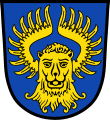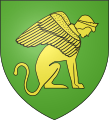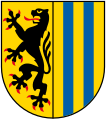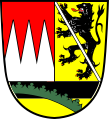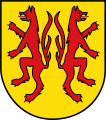Lion (heraldic animal)
The lion is a common figure in heraldry and the most popular heraldic animal . He symbolizes courage and royalty, as he is considered the "king of animals".
Symbolism and use

The lion has been depicted since the Stone Age . This is how the ice age hunters depicted the lion in the culture stage of the Aurignacien more than 30,000 years ago. The characteristic of the lion as the “king of animals”, which is widespread in many cultures, goes back to the influence of the Physiologus , an early Christian book on animal symbolism that had a great general influence on Western culture. The royal symbolism has been repeatedly taken up in history to register or reinforce claims to power, for example by Henry the Lion . The fascination emanating from this is still evident today through the large number of coats of arms on which the lion is depicted in various colors and shapes (see below).
In ancient times, the lion was common throughout the Mediterranean. In Greek mythology , lions appear in various functions: The Nemean lion was depicted as a man-eating beast, and killing it was one of Herakles' twelve tasks . In the story of Androclus , one of Aesop's fables , the hero, a runaway slave, pulls a thorn from a lion's paw; When he is later thrown to the lions to eat as a punishment for his flight, the animal recognizes him and refuses to kill the man. The winged lion is mentioned in the Bible (Daniel 7.4) and assigned to the evangelist Mark in Christian iconography . The lion also played a role in numerous other ancient cultures. In Egypt , pharaohs were represented as sphinxes , lions with a human head. The most famous such representation is the Great Sphinx of Giza . Egyptian mythology also knew Dedun , the Upper Egyptian god of wealth.

The lion has been depicted frequently in Persian art for over 3000 years. Also there and later in Islam the animal or a person with this nickname is considered proud, courageous, authoritarian, (mostly) masculine and terrifyingly strong.
Heraldic lion
As is typical for heraldic depictions, the lion is also depicted in a strongly stylized manner. Typical body features such as the head, the paws and the tail are worked out very clearly, on the other hand the body is strongly slimmed down in the heraldic representation. In particular, the typical lion's mane is reduced to a few fringes, sometimes completely omitted.
In contrast to the heraldic leopard , the heraldic lion is erected or rising in profile , i.e. H. shown standing on the hind feet. He looks straight ahead. This representation is the basic form and does not have to be reported when blazoning . If the lion is depicted walking and looking straight ahead, heraldry speaks of a walking or leoparded lion. If he is standing on his hind feet (erect or rising), but has turned his head towards the viewer (looking around), it is a lioned leopard. In addition, there is the lion looking backwards and only the leopard head looking forward. Rarely are seated or lying lion. The lion's tail is shown singly or twice in the coat of arms. It is then a double-tailed lion, and there are even more tails. The curvature of the tail is emblazoned only in exceptional cases. A maned lion is described as a lioness .
The heraldic lion is usually shown in gold, red or black. Silver or blue lions are rare. Sometimes the lion's weapons (especially the claws) and the knocked out tongue are tinged in a different color. This must be reported when blazoning . It is then called, for example, "a golden, red armored lion". The fact that the lion wears a crown must also be indicated accordingly, also with the color. Depictions of the animal with its tongue knocked out appear in coats of arms only after 1340. Before that and on seals, the tongue was not yet a distinguishing feature.
Lion head
Occasionally, only the lion's head is shown in the coat of arms. A distinction must be made between two basic variants. One variant shows a head with a straight cut at the neck and is emblazoned with "cut off" in the description of the coat of arms . With the other option, the mane covers this interface and it is described as "torn off". A head turned towards the viewer, i.e. placed en face, is a leopard head. This representation has been used at least since the 13th century. In modern heraldry, the term leopard head is not popular.
All heads can be changed with crowns or other decorative things or colors. However, it should be mentioned in the description of the coat of arms.
Prospective lion head with ring in its mouth ( door knocker ) in shield and coat of arms
The lion leopard
Leopard in an upright position, looking at the viewer. This difference did not exist in the Middle Ages.
Coat of arms of the former city of Remda
Coat of arms of the former city of Teichel
Bad Blankenburg coat of arms
Leoparded lion
Striding lions, heraldic look to the right.
Striding lion in the coat of arms of Baden-Württemberg
Leoparded lion in the coat of arms of Edenbergen (near Augsburg )
Special forms
Coat of arms of Lobberich , tongued in red in a three-pass
Coat of arms of Oberickelsheim , winged St. Mark's lion , always lying or standing / striding, the wings in the same color.
Alteglofsheim's coat of arms : winged lion head (leopard head)
Burgas : lion with fish tail ( sea lion )
Sphinx (female lion) in Bessines-sur-Gartempe, France
In gold a soaring red lion, tailed with a green peacock bump in the coat of arms of Fällanden
The following mythical creatures are considered independent figures:
- Man lion and woman lion: With the torso of a man as a man lion and with the torso of a woman as a woman lion, known in heraldry. The latter representation of a lion is also called the Sphinx .
- the griffin is a fantasy figure in heraldry, an eagle torso combined with a lion's abdomen
- the panther , a lion-footed, mostly dragon-headed animal
- the sea lion is a heraldic animal with the lion's front part and the rear part as a fish tail
- Another mythical creature with the head of a lion is the manticore
- the chimera in heraldry is represented with a girl's face, lion's mane, lion's feet, goat's body and a dragon's tail.
- the eagle lion , combination of eagle head and lion body
Examples
Lions with special names
| image | Surname | Appearance and / or meaning |
|---|---|---|

|
Ashoka Lion | Heraldic animal of India . This lion has three heads facing in different directions that have a body. |

|
Bamberg lion | In gold, a red armored black lion covered with a silver sloping bar (also left-facing with a left sloping bar). Heraldic animal of the bishopric of Bamberg. |
|
|
Bavarian lion | The Bavarian lion holds the Bavarian state coat of arms and is a symbol of Bavaria, among other things on monuments and awards. |

|
Bergischer lion |
In silver a double-tailed, blue-armored, blue-tongued and blue-crowned red lion.
The Bergisch lion was the heraldic animal of the Duchy of Berg . |

|
Bohemian lion | In red a double-tailed, gold-armored and tongued silver lion with a gold crown of leaves. |

|
Brunswick lion | Braunschweig's heraldic animal modeled on a statue in Braunschweig . In a silver shield there is a black-armored, silver-toothed red lion ( heraldically turned to the right ). |

|
above Brabant lion below Limburg lion |
In black, a golden, red-tongued and red-armored lion. In silver, a red, double-tailed, gold-crowned, tongued and armored lion. |

|
Colorful lion | Heraldic animal of the federal states of Hesse and Thuringia |
|
|
Flemish lion , also Flemish lion | In gold, a red-armored and red-tongued black lion. In the coat of arms of Flanders . |

|
Folkung lion | Shield holder in the large Swedish national coat of arms |

|
Geldern (sch) er lion ( Duchy of Geldern ) | In blue a red-armored, red-tongued and red-crowned golden lion. |

|
Habsburg Lion | In gold, a blue-armored, blue-tongued and blue-crowned red lion. Althabsburg, later with the Bindenschild family coat of arms, and from there into the coats of arms of the Roman-German and Austrian emperors from the 12th to the 20th century, frequently throughout Europe. |

|
Heinsberg lion | In red, crowned, double-curved silver / white lion, turned right. |

|
Itterscher Löwe ( Haus Itter ), also Eversteiner Löwe ( Haus Everstein ) | In blue a red-tongued and armored, gold-crowned, silver lion. |

|
Lion of Judas | A blue lion in gold. The Lion of Judah. |

|
Jülich lion | In gold a red-tongued and red-armored black lion. |

|
Ruthenian lion | Heraldic animal of the Ruthenian Kingdom , the Ruthenian Voivodeship and the Western Ukrainian People's Republic .
|

|
Lion of León | In silver a red-armored, red-tongued and gold-crowned purple lion. |

|
Lüneburg Lion ( Principality of Lüneburg ) | In gold, sprinkled with red hearts, a double-tailed, red-armored and red-tongued blue lion. |

|
St Mark's Lion | The St. Mark's lion - a winged, golden-nimbed silver lion lying here - is the symbol of the evangelist Mark and heraldic animal of Venice . |

|
Marzocco | The Marzocco lion is the shield holder in the coat of arms of Florence . |

|
Meissen Lion ( Margrave of Meissen ) | In gold, a red-armored and red-tongued black lion. |

|
Carrot lion | With the head of an African ( Moor for black skin color). Moorish lion in the coat of arms of Abfaltersbach (Tyrol) . |

|
Nassau lion | The Nassau lion is particularly common in the Westerwald and Taunus . A red-armored, red-tongued golden lion. Mostly in a blue field sprinkled with golden shingles. |

|
Palatinate lion | The Palatinate Lion is particularly widespread in southern Germany in the federal states of Baden-Württemberg, Bavaria, Rhineland-Palatinate and Saarland. A red-armored, red-tongued and red-crowned golden lion. |

|
Sayner lion | The Sayner lion can be found in various coats of arms of the Westerwald. In red a blue- armored and -tongued , golden, looking, double-tailed lion (lioned leopard). |

|
Schleswig lions | The Schleswig lions appear in various Schleswig coats of arms. In gold, two striding, red-armored and red-tongued blue lions in stakes. |

|
Staufer lions | Three Staufer lions in the coat of arms of Baden-Württemberg . |

|
Veldenzer Lion (County Veldenz) | In silver a red-tongued, gold-armored and gold-crowned blue lion. |
|
|
Guardian lion | As a shield holder in the coat of arms of Myanmar . |
Lion coat of arms
- Standard lions
Meissen lion in the coat of arms of Leipzig
Double-tailed silver Bohemian lion in the coat of arms of the Czech Republic
National coat of arms of Denmark with three striding blue lions
Einbeck coat of arms
Two striding golden lions in the coat of arms of the canton of Thurgau (Switzerland)
Three striding lions in the coat of arms of the municipality of Freienbach (Switzerland)
Two striding red lions in the coat of arms of Winterthur (Switzerland)
almost identical: Weesen (Switzerland)
Blue lion in the coat of arms of Wollerau (Switzerland)
Striding lion in the coat of arms of Hauenstein-Ifenthal (Switzerland)
Rising lion in the coat of arms of Lauenau
Lion in the coat of arms of the city of Wuppertal
Blue-armored and tongued red lion from Pfalz-Zweibrücken in the coat of arms of Winterbach
Red-armored and black-tongued Bamberg lion ( Haßberge district )
Swept away and erect to defend ( Peine district )
Black Jülich lion in the Brachelen coat of arms
Masked Bohemian lion with arm rings and helmet: Aussig
Black lion with ladder in the coat of arms of the community of Löwenberger Land
List of other lion coats of arms:
- Municipalities and cities: Auerbach / Vogtl. , Braunschweig , Burgdorf (Hanover region) , Dresden , Düsseldorf , Ebenthal (Austria), Eisfeld , Frankenthal (Palatinate) , Freiberg , Gelsenkirchen , Gera , Gifhorn , Görlitz , Großenhain , Kindelbrück , Königstein (Saxon Switzerland) , Landau in the Palatinate , Bad Lauchstädt , Lauenstein , Leonberg , Leutenberg , Leverkusen , Lünen , Magdala , Markneukirchen , Markkleeberg , Meißen , Mittweida , Mühlberg / Elbe , Neustadt an der Weinstrasse , Oelsnitz / Vogtl. , Orlamünde , Ortrand , Oschatz , Passau , Pausa-Mühltroff , Pegau , Plaue , Plech , Pößneck , Rain (Lech) , Ranis , Rastede , Rudolstadt , Sayda , Schöneck / Vogtl. , Siebenlehn , Sonneberg , Weimar , Wittingen , Wuppertal , Zweibrücken
- Counties, regions and states: Birkenfeld , district of Celle , the district Chemnitzer Land , district Freiberg , Gifhorn , Hamelin-Pyrmont district , district of Harburg , district of Holzminden , Kyffhäuserkreis , Leer district , Rhein-Lahn-Kreis , district Loerrach , Rhein-Sieg -Kreis , Regionalverband Saarbrücken , Region Hanover , Bavaria (federal state), Thuringia (federal state), Province Limburg (Belgium) , Province Limburg (Netherlands) , Region Franche-Comté (France)
- States: Kingdom of Belgium , Bulgaria , Denmark , Estonia , Finland , Great Britain , Latvia , Grand Duchy of Luxembourg , Montenegro , Netherlands , Norway , Spain , Czech Republic
- Former states: Grand Duchy of Hesse
- Associations and organizations: Eintracht Braunschweig , TSV 1860 Munich
- additional. u. Web links
Shield holder lions
With the unicorn shield holder in the coat of arms of the United Kingdom
Lions in the Bavarian state coat of arms
Fish-tailed lions in the Lelystad coat of arms
Lions in the coat of arms of Kenya
See also
Web links
Individual evidence
- ^ Karl Schlamminger, Peter Lamborn Wilson : Weaver of Tales. Persian Picture Rugs / Persian tapestries. Linked myths. Callwey, Munich 1980, ISBN 3-7667-0532-6 , pp. 145-147.
- ^ Walter Leonhard: The great book of heraldic art. Development, elements, motifs, design. 2nd, revised and expanded edition. Georg DW Callwey, Munich 1978, ISBN 3-7667-0345-5 .
- ↑ Gert Oswald : Lexicon of Heraldry. VEB Bibliographisches Institut, Leipzig 1984.
- ^ Milan boys : Heraldry. Edited edition. Albatros, Prague 1987.













